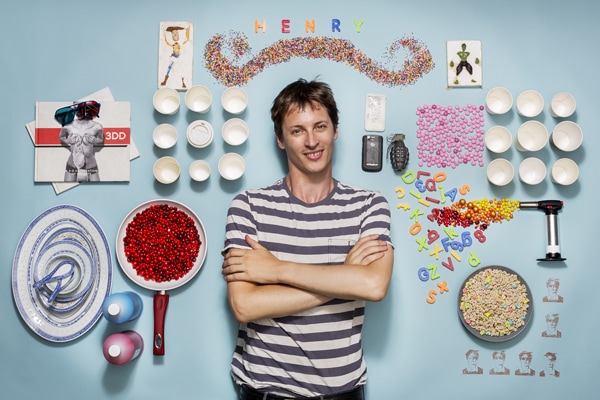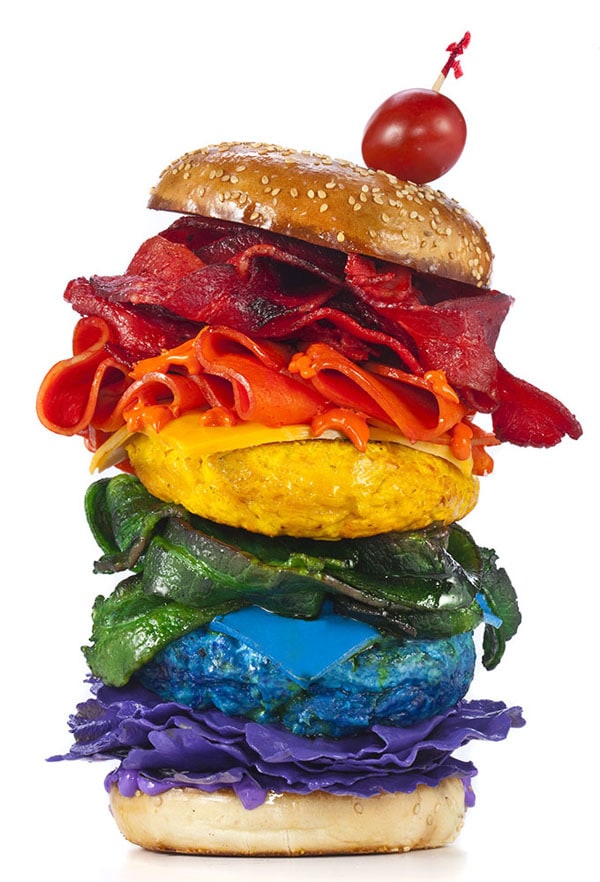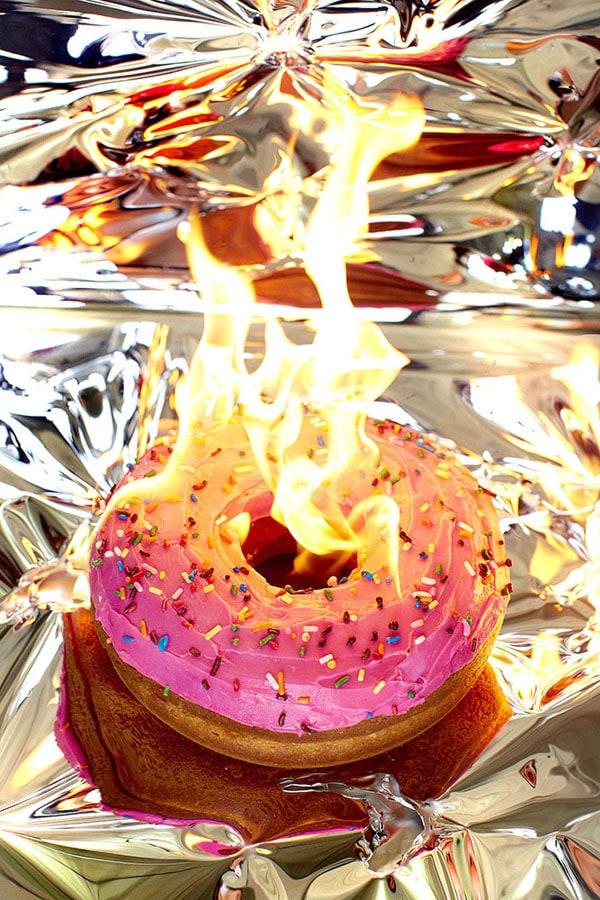Share
Creative Food Photography Projects: Thinking Outside the Box with Henry Hargreaves
A native New Zealander and current resident of Brooklyn, N.Y., Henry Hargreaves, didn’t move to New York to make it as a photographer. He was a f...

A native New Zealander and current resident of Brooklyn, N.Y., Henry Hargreaves, didn’t move to New York to make it as a photographer. He was a fashion model and bartender who eventually realized he’d rather be behind the camera than in front of it. Now, with work spanning the worlds of fine art, commercial and editorial photography he’s best known for food-focused visual projects, like a series recreating the last meals of death row inmates or maps of the continents made of food representing their regions.
How did you get into photographing food?
I started off doing more commercial and still life photography and was working at a restaurant. I just loved the way food says so much about us that’s really hard to articulate. I started to get a lot of food assignments and realized that people weren’t really doing that many interesting things with food. I wanted to use food as a sort of storytelling device in this common denominator between the viewer and the subject.
I do very little editorial work because I hate that process of design by committee. The art directors so seldomly come on set these days. Instead they want you to take a picture and email it to them. Then they show it to their team, everyone’s got an opinion, it comes back, and they want you to change something. It goes back and forth, and it’s not a very creative and fun process. And it doesn’t pay much. I do it every now and again when it’s a prestigious magazine or someone I really like or as an opportunity where I can get full creative control.
For my personal work, I commission myself to do the project. I became a photographer to have fun and be able to tell stories so that’s why my personal work becomes priority.

Photo by Henry Hargreaves
How do you turn personal projects into paying work?
I monetize it in terms of usage from magazines if they want to publish my pictures. It also leads to gallery shows. Things start going around the Internet like wildfire, and before you know it people want to show the work because now it’s tried and true.They can see how many views I’ve had and how many times things have been shared. I also do commercial work because that’s what brings in the money that allows the personal work to happen. I’m really lucky to be at a point now where a lot of the commercial work is based on my personal work. That’s a really great place to be.
Do you consider yourself a food photographer?
I don’t really consider myself a photographer anymore. I’m really more of an artist or a food artist. The photo really just documents what I made. I came from more of a tradi- tional photography background, but to me the art is in what I’ve concepted and made. The picture documents it so it can be shared with other people afterwards because food is so temporary. It’s a sculpture. I feel that the way photography is moving these days, so many of these pictures could be taken by anyone. I don’t see my value as being a photographer. I see my value as being an artist.

Photo by Henry Hargreaves
What are your brainstorming techniques for coming up with new series’ concepts?
I get a lot of my ideas from trawling the Internet and seeing blogs. I don’t look at much photo-related stuff because if I see something I really like I often get more of that sense of “I wish I’d done that” as opposed to it inspiring me to do something totally different. I look much more at graphic design blogs and funny lifestyle things. I’ll see something and think, wouldn’t it be fun to turn that concept on its head and make it out of food.
I’ve literally got a black book full of ideas. I always say an idea is worthless until you’ve actually gone and executed it. I have no idea whether the concept is going to be good or bad until I’ve done it. To me, the most frustrating thing is to not do these things, to be that person who has a million ideas but is always too busy. I think the mark of any successful creator is to be able to find time to make these things happen.
Do you work with stylists?
My primary collaborator is Caitlin Levin. We started off as more of a photographer and a stylist, but I think the relationship now is we see ourselves as equal collaborators. Sure, she’s a stronger cook and I’m strong with photography, but ultimately, they are skills that can be learned and anyone can have. So when we make things together, we both get involved in the process. She’ll weigh in on how she thinks things could be lit better, and I’ll actually get my fingers dirty in the whole food thing, rearranging and organizing and cutting. So it becomes a total collaboration. I like that. I don’t think that we should define ourselves with these boundaries. I work much stronger with people bouncing ideas off people. And because she hasn’t learned the way I’ve learned about things, she has a very unique perspective, which can take things to these great and unexpected places.
How has your unique take on food translated into securing clients? What kinds of clients are interested in your work?
Ultimately I try to stay true to myself with my personal projects and create something I would like to see. I just assume there’s an audience of like-minded individuals such as myself out there. So ultimately it becomes something that people want to share. And it’s not aggressively commercial. Clients are coming to me now and saying what you do is really fun and sharable. For instance, MasterCard came to Caitlin with a campaign about going out and having a dinner for two. They asked if we could do some cool food things that relate to a memorable experience on a table for two people. It’s not so much an ad; it was more just a cool image they can associate it with. That’s where a lot of things are moving because traditional advertising is dying a slow death. People aren’t really watching TV ads anymore, and it’s all becoming about the Internet. The future is to create content that very subtly is product placement but is driven by really cool, fun imagery.

Photo by Henry Hargreaves
How do you go about pitching this work for publication or commercial use?
I’ve got an agent who does a lot of that for me. I don’t want to be that aggressive sales- person. I want to go in and just show people the projects I’ve done and explain what they’ve meant to me. The agent can do more of the business side of things. But when they do come to me with a direction, I’ll sketch what I think will be fun and interesting and also talk to people who I might collaborate with. I’ll present my idea and say if that works for you, let’s do it. But I really don’t like too many revisions.
The other thing that happens that I’m totally transparent about is if someone asks me to execute a concept and it’s a good day rate, I’ll do it because that’s what pays the rent on my studio and allows me to do all those sorts of things. With commercial work, you often don’t have your name attached to it so you can make those compromises.
What are your thoughts about contemporary food photography?
I think for me the future of this genre is massive. Suddenly the great cameras on the smartphones have allowed everyone to become a photographer, and food has become one of the biggest themes that people are shooting. So suddenly the awareness of food pho- tography is rising and, with it, food art, because content is always going to be the primary thing. Really good content with good pictures is what swims to the top of the surface.
It’s going to be interesting to see how it all goes in the next 10 years. I’m excited. I’m enthusiastic about it, and I’m going to keep moving forward, creating my own things and pushing the envelope.
For more tips to leverage your food photography skills, check out The Professional’s Guide to Food Photography.



